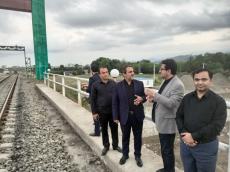|
|
TODAY.AZ / Business
Azerbaijan, Iran, Russia to mull transit, customs issues
11 August 2022 [17:59] - TODAY.AZ

By Azernews
By Sabina Mammadli
Iranian, Azerbaijani, and Russian officials will discuss the diversification of the routes on the International North-South Transport Corridor (INSTC) in the near future, Iranian Ambassador to Azerbaijan Seyyed Abbas Mousavi said.
The remarks were made during the ambassador’s visit to Iran’s Astara city, where he got acquainted with the joint projects being implemented between Iran and Azerbaijan.
Mousavi added that Iran’s Astara is one of the main and important parts of the INSTC. With the completion of work within the projects being implemented in Astara, its regional and international importance will reveal itself even further.
“Regarding these projects and other transit issues between the two countries, Iranian Minister of Roads and Urban Development Rostam Ghasemi and Minister of Digital Development and Transport of Azerbaijan Rashad Nabiyev will soon meet,” he noted.
At present, a railway terminal is being built between Iran and Azerbaijan in Iran’s Astara city. A part of this railway terminal has already been put into use.
To recap, on January 25, 2022, the foundation of a new bridge over the Astarachay River on the Azerbaijani-Iranian border was laid. The construction of the 89-meter-long and 30-meter-wide bridge is expected to be completed by the end of the year.
The foundation of the International North-South Transport Corridor was laid on the basis of an intergovernmental agreement signed between Russia, Iran, and India on September 12, 2000.
In total, 13 countries have ratified the agreement, including Azerbaijan, India, Iran, Russia, Türkiye, etc.
The purpose of creating a corridor is to reduce the delivery time of cargo from India to Russia, as well as to North and West Europe. Delivery time on the current route is more than 6 weeks, it is expected to be reduced to 3 weeks via North-South Transport Corridor.
The 175 km long Qazvin-Rasht railway was officially put into operation on March 6, 2019, to connect Azerbaijani railways with the Iranian railway network within the corridor. In addition, the 167 km long Rasht-Astara railway line must be built in Iran.
URL: http://www.today.az/news/business/224052.html
 Print version
Print version
Connect with us. Get latest news and updates.
See Also
- 03 February 2025 [20:34]
Azerbaijan's Azercosmos sees decline in satellite service exports - 03 February 2025 [18:38]
Azerbaijan's tourism potential demonstrated in Pakistan - 03 February 2025 [13:35]
German-Azerbaijani Chamber of Commerce holds meeting on tax and legal reforms - 01 February 2025 [16:52]
Azerbaijan-Kyrgyz Investment Fund to finance hydro and textile projects - 31 January 2025 [14:56]
Azerbaijan aims to boost private sector share in GDP, says official - 31 January 2025 [13:17]
New highways planned for Baku under 2025–2030 Transport Program - 31 January 2025 [13:06]
Azerbaijan to align National Priorities with New UN Framework for 2026-2030 - 31 January 2025 [12:45]
Azerbaijan ready to collaborate for digital future, Prime Minister - 31 January 2025 [12:07]
Azerbaijan proposes key priorities for new UN cooperation framework - 30 January 2025 [14:49]
Azerbaijan, Pakistan discuss strengthening energy sector ties
Most Popular
 Elon Musk reveales launch date of Tesla robotaxi
Elon Musk reveales launch date of Tesla robotaxi
 What is wrong with the Armenian Constitution? - a reminder for Pashinyan
What is wrong with the Armenian Constitution? - a reminder for Pashinyan
 Microsoft investigating ongoing issue disrupting access to Microsoft 365 Services and Admin Tasks
Microsoft investigating ongoing issue disrupting access to Microsoft 365 Services and Admin Tasks
 Turkiye achieves record tourism revenues last year
Turkiye achieves record tourism revenues last year
 Russia to implement new migration laws starting February 5
Russia to implement new migration laws starting February 5
 Humanoid robots dance at CCTV’s Chinese New Year Gala Concert
Humanoid robots dance at CCTV’s Chinese New Year Gala Concert
 EU plans sanctions on 50 Russian products in upcoming trade restrictions
EU plans sanctions on 50 Russian products in upcoming trade restrictions
